Spatial Profile of Neutral Temperature Measurement in Aditya-U Tokamak Plasmas
Abstract
1. Introduction
2. Experimental Arrangement and Technique to Measure Neutral Temperature
2.1. Experimental Setup
2.2. Technique for Estimating Neutral Temperature
3. Results and Discussion
4. Summary
Author Contributions
Funding
Acknowledgments
Conflicts of Interest
References
- Stangeby, P.; McCracken, G. Plasma boundary phenomena in tokamaks. Nucl. Fusion 1990, 30, 1225–1379. [Google Scholar] [CrossRef]
- Boivin, R.L.; Goetz, J.A.; Irby, J.H.; Marmar, E.S.; Mossessian, D.; Pitcher, C.S.; Carreras, B.A.; Owen, L.W.; Hubbard, A.E.; Hughes, J.W.; et al. Effects of neutral particles on edge dynamics in Alcator C-Mod plasmas. Phys. Plasmas 2000, 7, 1919–1926. [Google Scholar] [CrossRef]
- Stotler, D.P.; Scotti, F.; Bell, R.E.; Diallo, A.; Leblanc, B.P.; Podesta, M.; Roquemore, A.L.; Ross, P.W.; Stotler, D. Midplane neutral density profiles in the National Spherical Torus Experiment. Phys. Plasmas 2015, 22, 082506. [Google Scholar] [CrossRef]
- Dey, R.; Ghosh, J.; Chowdhuri, M.; Manchanda, R.; Banerjee, S.; Ramaiya, N.; Sharma, D.; Srinivasan, R.; Stotler, D. Investigation of neutral particle dynamics in Aditya tokamak plasma with DEGAS2 code. Nucl. Fusion 2017, 57, 86003. [Google Scholar] [CrossRef]
- Reiter, D.; Baelmans, M.; Börner, P. The EIRENE and B2-EIRENE Codes. Fusion Sci. Technol. 2005, 47, 172–186. [Google Scholar] [CrossRef]
- Schneider, R.; Bonnin, X.; Borrass, K.; Coster, D.P.; Kastelewicz, H.; Reiter, D.; Rozhansky, V.A.; Braams, B.J. Plasma Edge Physics with B2-Eirene. Contrib. Plasma Phys. 2006, 46, 3–191. [Google Scholar] [CrossRef]
- Hinton, F.L.; Hazeltine, R.D. Theory of plasma transport in toroidal confinement systems. Rev. Mod. Phys. 1976, 48, 239–308. [Google Scholar] [CrossRef]
- Čadež, I.; Markelj, S.; Rupnik, Z.; Pelicon, P. Processes with neutral hydrogen and deuterium molecules relevant to edge plasma in tokamaks. J. Phys. Conf. Ser. 2008, 133, 12029. [Google Scholar] [CrossRef]
- Samm, U. The TEXTOR-94 Team Progress in plasma-wall-interaction research—Contributions from TEXTOR-94. Plasma Phys. Control. Fusion 1999, 41, B57–B76. [Google Scholar] [CrossRef]
- Hey, J.D.; Korten, M.; Lie, Y.T.; Pospieszczyk, A.; Rusbüldt, D.; Schweer, B.; Unterberg, B.; Wienbeck, J.; Hintz, E. Doppler Broadening and Magnetic Field Effects on the Balmer Lines Emitted at the Edge of a Tokamak Plasma. Contrib. Plasma Phys. 1996, 36, 583–604. [Google Scholar] [CrossRef]
- Kunze, H.-J. Introduction to Plasma Spectroscopy; Springer: Berlin/Heidelberg, Germany, 2009; Volume 56. [Google Scholar]
- Shikama, T.; Kado, S.; Zushi, H.; Iwamae, A.; Tanaka, S. Application of the Zeeman patterns in Ov and Hα spectra to the local plasma diagnostics of the TRIAM-1M tokamak. Phys. Plasmas 2004, 11, 4701. [Google Scholar] [CrossRef]
- Shikama, T.; Kado, S.; Zushi, H.; Sakamoto, M.; Iwamae, A.; Tanaka, S. Application of the Zeeman patterns to the measurement of local neutral behaviour in the edge plasma of TRIAM-1M tokamak. Plasma Phys. Control. Fusion 2006, 48, 1125–1139. [Google Scholar] [CrossRef]
- Ghosh, J.; Griem, H.R.; Elton, R.C.; Terry, J.L.; Marmar, E.; Lipschultz, B.; LaBombard, B.; Rice, J.E.; Weaver, J.L. Measurements of ion and neutral atom flows and temperatures in the inner and outer midplane scrape-off layers of the Alcator C-Mod Tokamak. Phys. Plasmas 2004, 11, 1033–1042. [Google Scholar] [CrossRef]
- Blom, A.; Jupén, C. Parametrization of the Zeeman effect for hydrogen-like spectra in high-temperature plasmas. Plasma Phys. Control. Fusion 2002, 44, 1229–1241. [Google Scholar] [CrossRef]
- Yadava, N.; Ghosh, J.; Chowdhuri, M.B.; Manchanda, R.; Sripathi, P.K.; Dey, R.; Raj, H.; Banerjee, S.; Tanna, R.; Jadeja, K.A.; et al. Observation of poloidal asymmetry in measured neutral temperatures in the Aditya-U tokamak plasma. Nucl. Fusion 2019, 59, 106003. [Google Scholar] [CrossRef]
- Goto, M.; Sawada, K.; Fujii, K.; Hasuo, M.; Morita, S. Evaluation of hydrogen atom density in the plasma core region based on the Balmer-line profile. Nucl. Fusion 2011, 51, 023005. [Google Scholar] [CrossRef]
- Takenaga, H.; Higashijima, S.; Sakasai, A.; Hosogane, N.; Kubo, H.; Sugie, T.; Suzuki, S. The spectral profile of the line emitted from the divertor region of JT-60U. Plasma Phys. Control. Fusion 1998, 40, 1115–1126. [Google Scholar]
- Koubiti, M.; Marandet, Y.; Escarguel, A.; Capes, H.; Godbert-Mouret, L.; Stamm, R.; De Michelis, C.; Guirlet, R.; Mattioli, M. Analysis of asymmetric Dα spectra emitted in front of a neutralizer plate of the Tore-Supra ergodic divertor. Plasma Phys. Control. Fusion 2002, 44, 261–275. [Google Scholar] [CrossRef]
- Kammler, T.; Wehner, S.; Küppers, J. The role of sticking and reaction probabilities in hot-atom mediated abstraction reactions of D on metal surfaces by gaseous H atoms. J. Chem. Phys. 1998, 109, 4071–4077. [Google Scholar] [CrossRef]
- Isler, R.C.; Wood, R.W.; Klepper, C.C.; Brooks, N.H.; Fenstermacher, M.E.; Leonard, A.W. Spectroscopic characterization of the DIII-D divertor. Phys. Plasmas 1997, 4, 355–368. [Google Scholar] [CrossRef]
- Iwamae, A.; Hayakawa, M.; Atake, M.; Fujimoto, T.; Goto, M.; Morita, S. Polarization resolved H[sub α] spectra from the large helical device: Emission location, temperature, and inward flux of neutral hydrogen. Phys. Plasmas 2005, 12, 42501. [Google Scholar] [CrossRef]
- Tanna, R.L.; Raj, H.; Ghosh, J.; Kumar, R.; Aich, S.; Macwan, T.; Kumawat, D.; Jadeja, K.A.; Patel, K.; Kalal, M.B.; et al. Overview of Operation and Experiments in the ADITYA—U Tokamak. Nucl. Fusion 2019. [Google Scholar] [CrossRef]
- Banerjee, S.; Ghosh, J.; Manchanda, R.; Dey, R.; Ramasubramanian, N.; Chowdhuri, M.B.; Patel, M.; Kumar, V.; Vasu, P.; Chattopadhyay, P.K.; et al. Observations of Hα emission profiles in Aditya tokamak. J. Plasma Fusion Res. 2010, 9, 29–32. [Google Scholar]
- Gao, W.; Huang, J.; Wu, C.; Xu, Z.; Hou, Y.; Jin, Z.; Chen, Y.; Zhang, P.; Team, E. Analysis of the Zeeman effect on D α spectra on the EAST tokamak. Chin. Phys. B 2017, 26, 45203. [Google Scholar] [CrossRef]
- Dey, R.; Chowdhuri, M.B.; Ghosh, J.; Manchanda, R.; Yadava, N.; Ramaiya, N.; Banerjee, S.; Nagora, U.C.; Atrey, P.K.; Raval, J.V. Investigation of atomic and molecular processes in Hα emission through modelling of measured Hα emissivity profile using DEGAS2 in the ADITYA tokamak. Nucl. Fusion 2019, 59, 076005. [Google Scholar] [CrossRef]
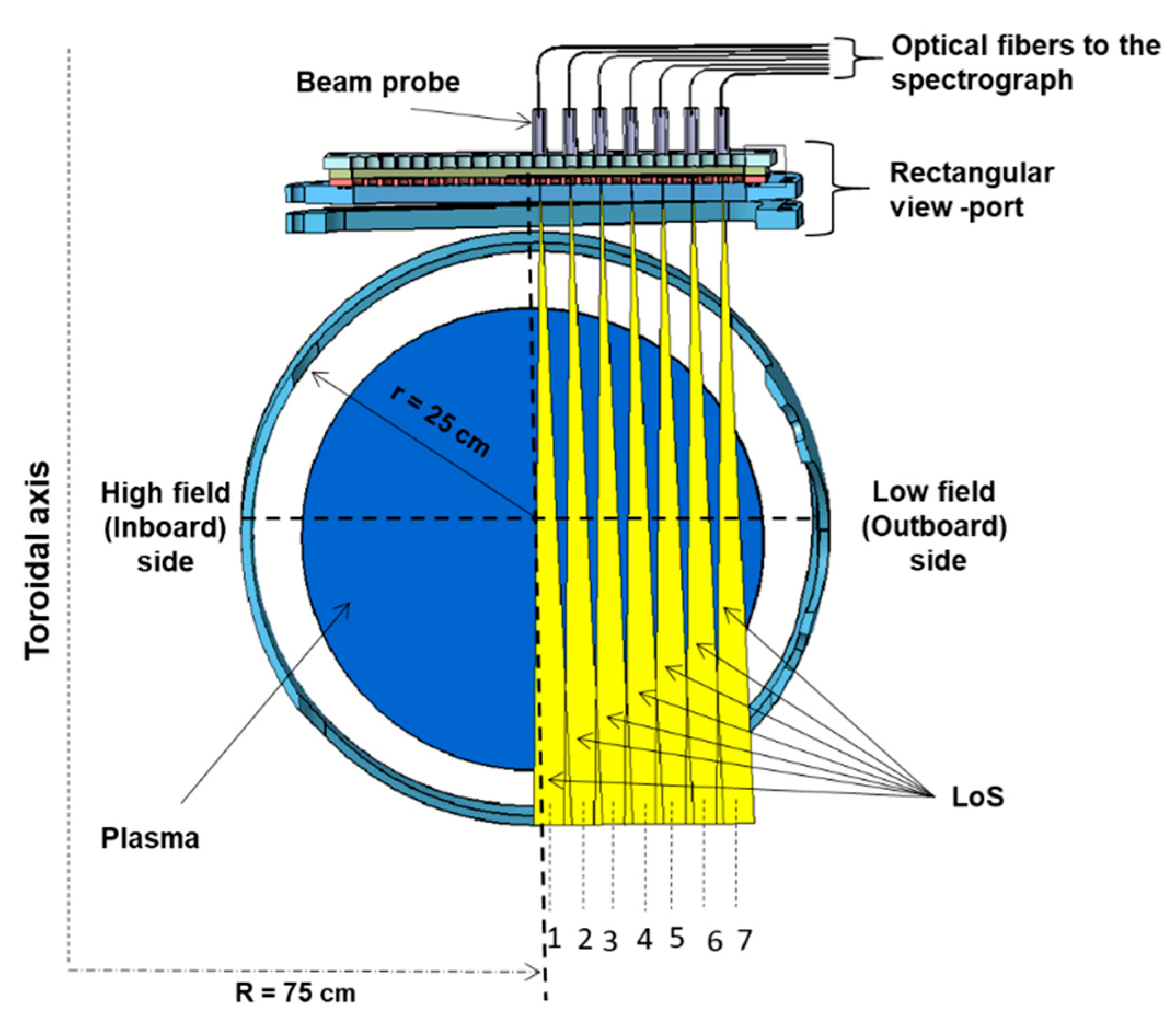
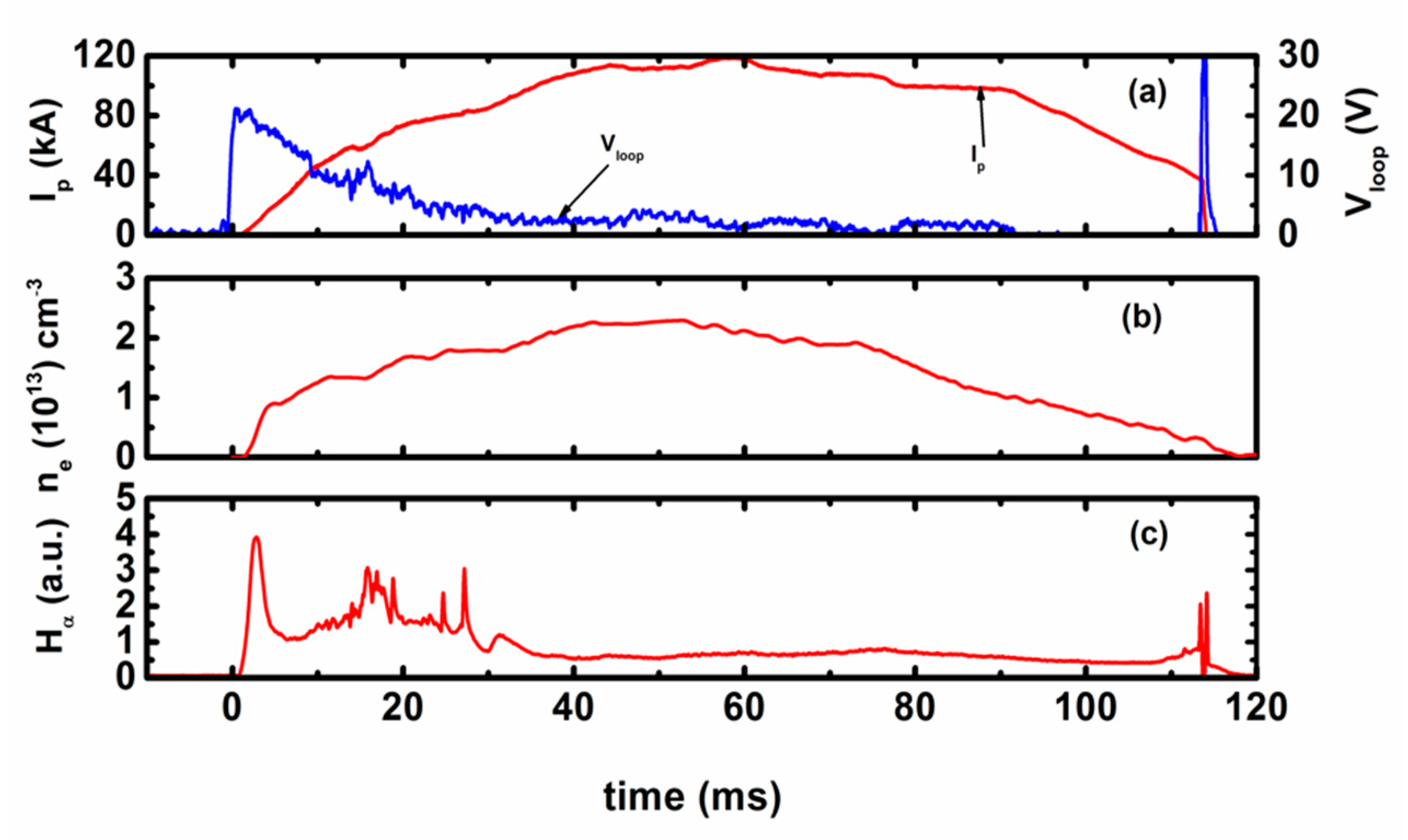
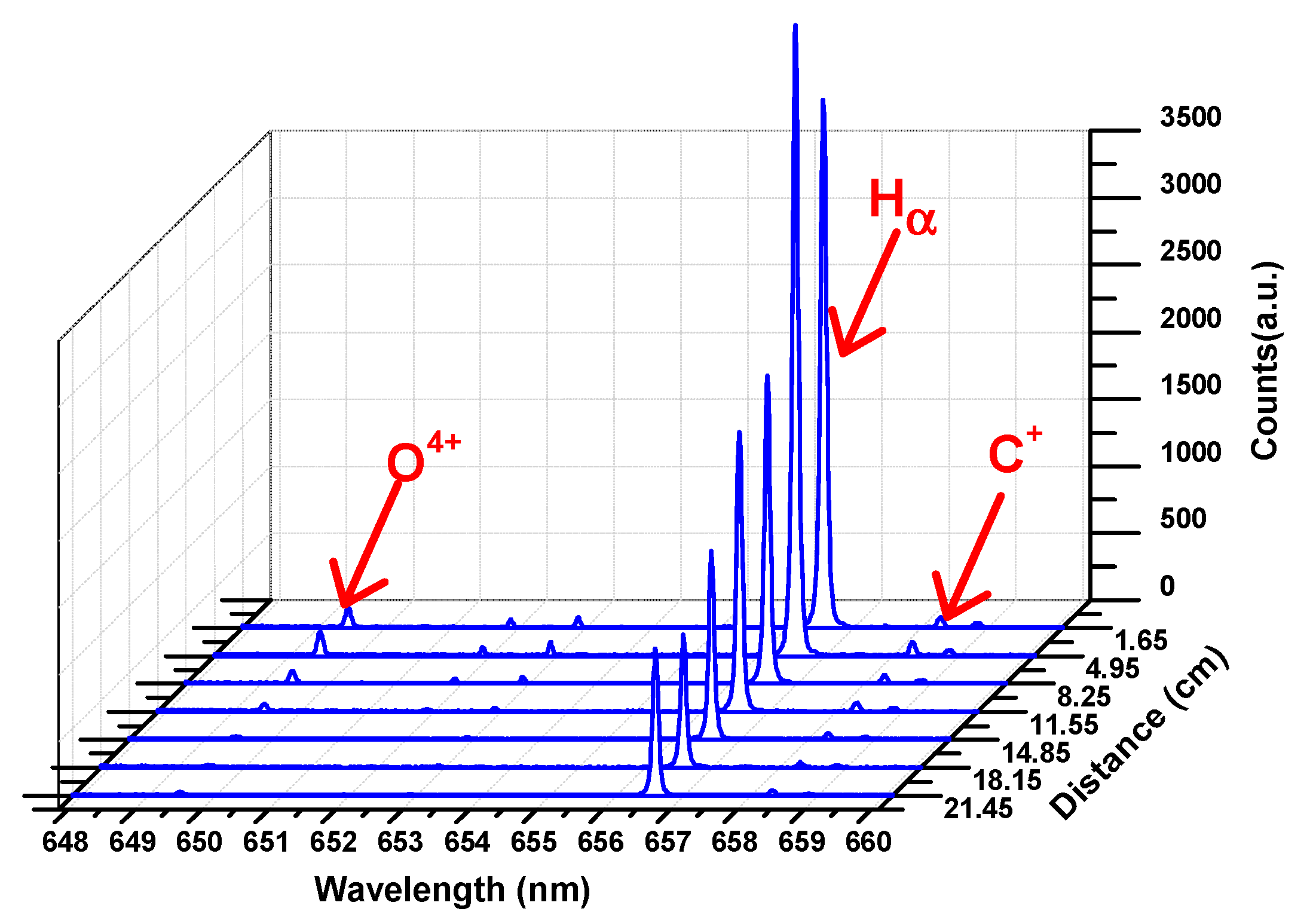
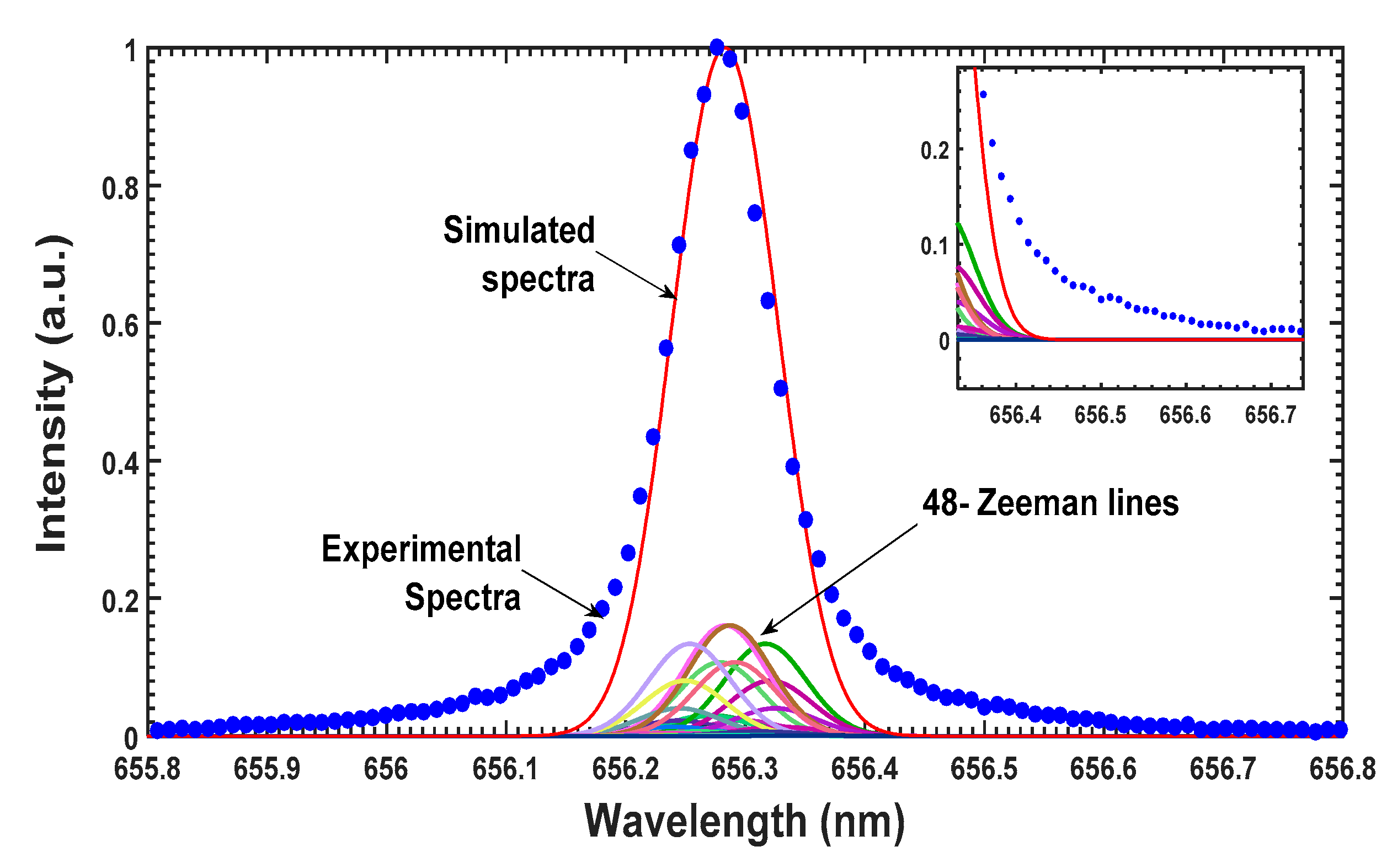
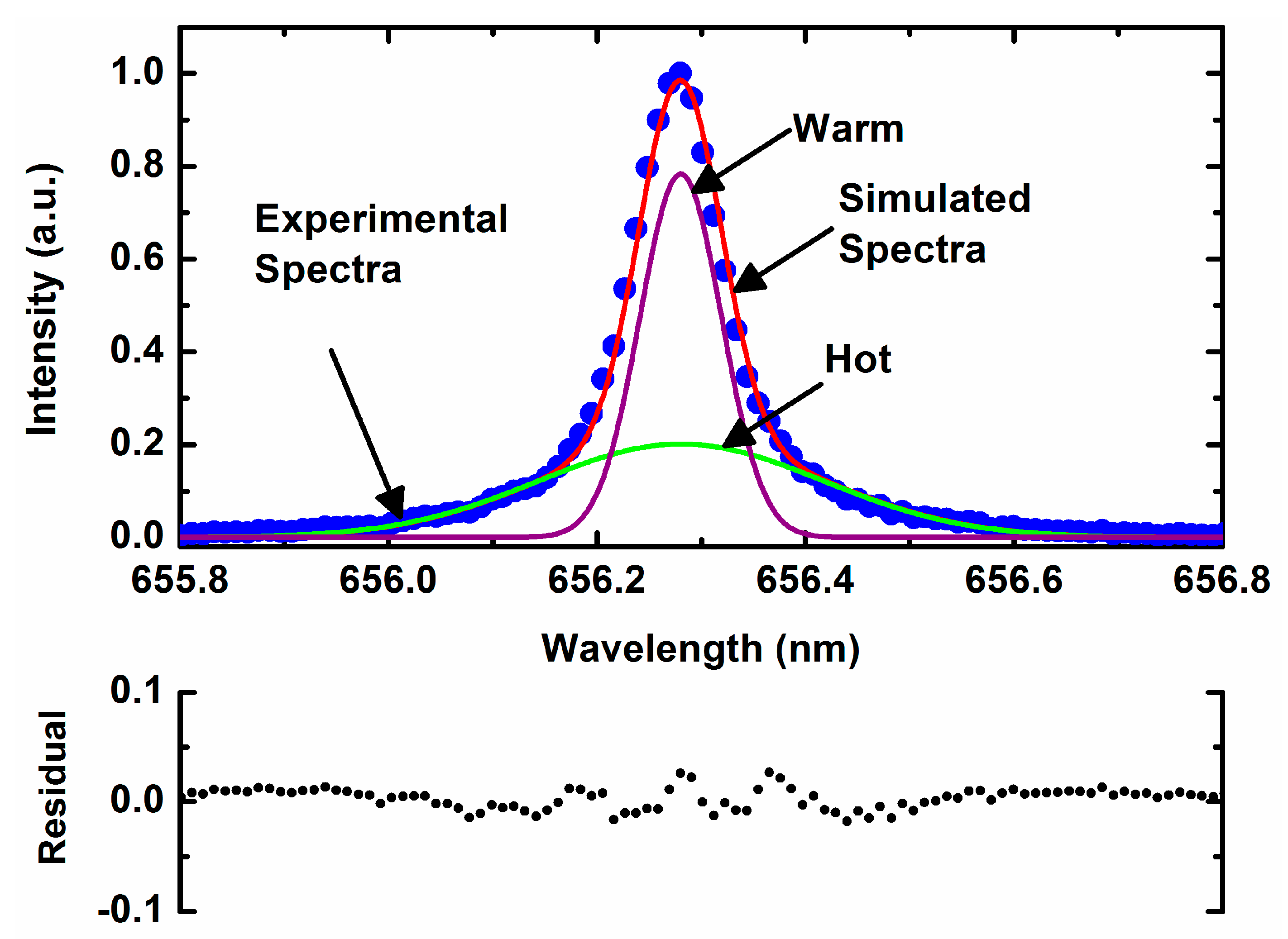
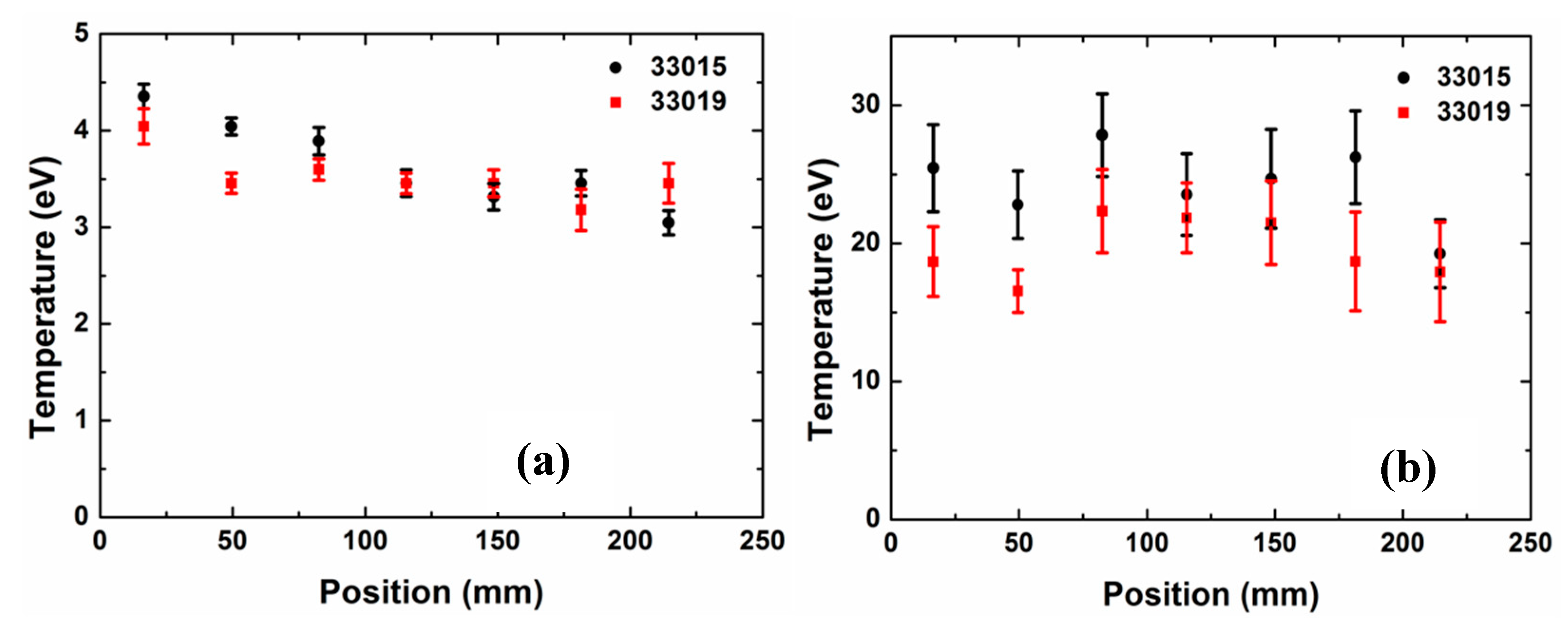
© 2019 by the authors. Licensee MDPI, Basel, Switzerland. This article is an open access article distributed under the terms and conditions of the Creative Commons Attribution (CC BY) license (http://creativecommons.org/licenses/by/4.0/).
Share and Cite
Yadava, N.; Ghosh, J.; Chowdhuri, M.B.; Manchanda, R.; Punchithaya K, S.; Dey, R.; Jadeja, K.A.; Tanna, R.L.; Tripathi, D.; Aditya-U Team. Spatial Profile of Neutral Temperature Measurement in Aditya-U Tokamak Plasmas. Atoms 2019, 7, 87. https://doi.org/10.3390/atoms7030087
Yadava N, Ghosh J, Chowdhuri MB, Manchanda R, Punchithaya K S, Dey R, Jadeja KA, Tanna RL, Tripathi D, Aditya-U Team. Spatial Profile of Neutral Temperature Measurement in Aditya-U Tokamak Plasmas. Atoms. 2019; 7(3):87. https://doi.org/10.3390/atoms7030087
Chicago/Turabian StyleYadava, Nandini, Joydeep Ghosh, Malay Bikas Chowdhuri, Ranjana Manchanda, Sripathi Punchithaya K, Ritu Dey, Kumarpalsinh A. Jadeja, Rakesh L. Tanna, Deepti Tripathi, and Aditya-U Team. 2019. "Spatial Profile of Neutral Temperature Measurement in Aditya-U Tokamak Plasmas" Atoms 7, no. 3: 87. https://doi.org/10.3390/atoms7030087
APA StyleYadava, N., Ghosh, J., Chowdhuri, M. B., Manchanda, R., Punchithaya K, S., Dey, R., Jadeja, K. A., Tanna, R. L., Tripathi, D., & Aditya-U Team. (2019). Spatial Profile of Neutral Temperature Measurement in Aditya-U Tokamak Plasmas. Atoms, 7(3), 87. https://doi.org/10.3390/atoms7030087




